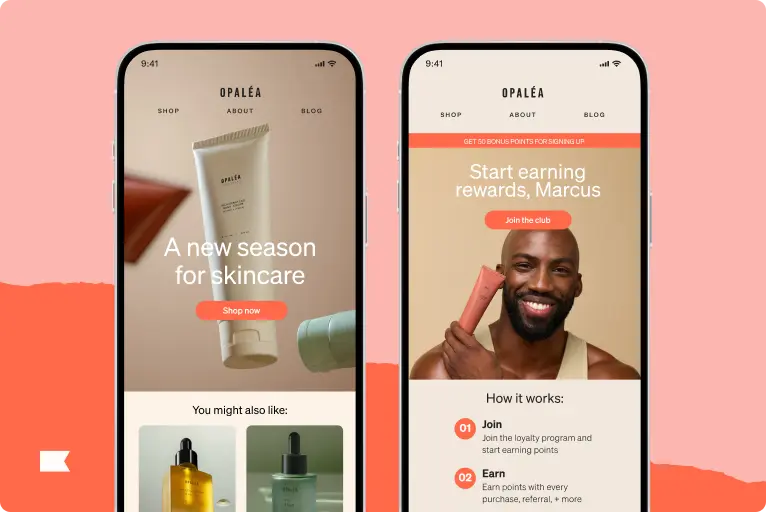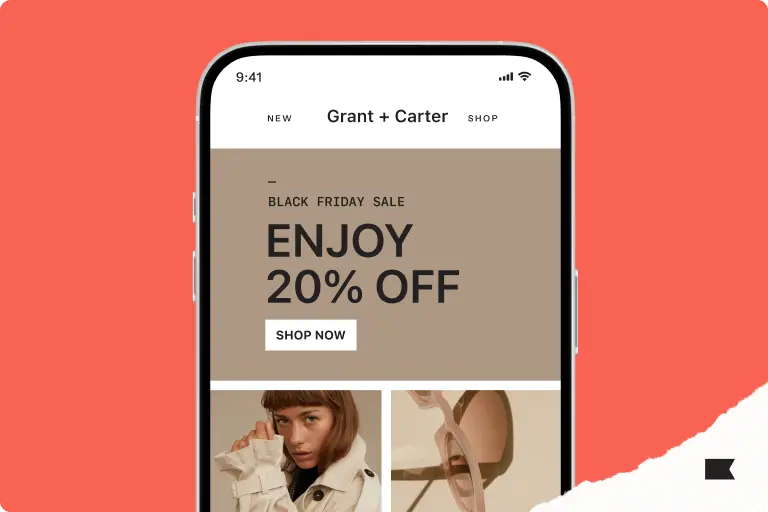What makes a great email subject line? 8 best practices to increase open rates, with examples
We’re obsessed with subject lines. And you should be, too.
Without a persuasive subject line that piques curiosity, your email body copy can’t do the work it was destined to do. No opens means no clicks—and no clicks means no revenue.
We’ve scoured through some of the best email subject line examples from our customers to reverse-engineer best practices and come up with some first principles to help you craft and test subject lines—and drive higher open rates.
Before you start: email open rates post-Apple iOS 15
We can’t talk about subject lines without first addressing how they’re measured: open rates.
Launched in June 2021, Apple’s iOS 15 privacy features allow Apple Mail users to block third parties from tracking email opens. Considering Apple owns 53.67% of email client market share, that means more than half of your brand’s open rate metrics don’t reflect how many people actually opened your email.
Ananda Farge, associate director of email and SMS marketing at Accenture, says she still values open rate—but only relative to itself and other metrics that inform her about the overall health of an email program.
“We know that a 60% open rate doesn’t mean 60% of people actually opened your email,” Farge says. “But if we had a 60% open rate on Monday, and on Tuesday we see a 40% open rate, we can compare campaigns and make decisions from there. Maybe deliverability dropped off, so we’ll look at that.”
More practically, the best way to manage this reality is to use your marketing automation platform to differentiate Apple’s Mail Privacy Protection (MPP) from true recipient engagement. The purpose of this is to avoid seeing inflated email open rates that may lead you to believe your subject lines are more effective than they really are.
Klaviyo handles this with a property called “Apple Privacy Open,” which is either true or false for all open events. If Apple Privacy Open is true, it means the message was opened on a device with MPP turned on. That means the open may be attributable to Apple’s MPP and doesn’t necessarily reflect a true email open.
The next step is to separate MPP opens from true opens by adding a filter where Apple Privacy Open equals false. This is the segment to test subject lines with, because you know an open from this segment is actually an open.
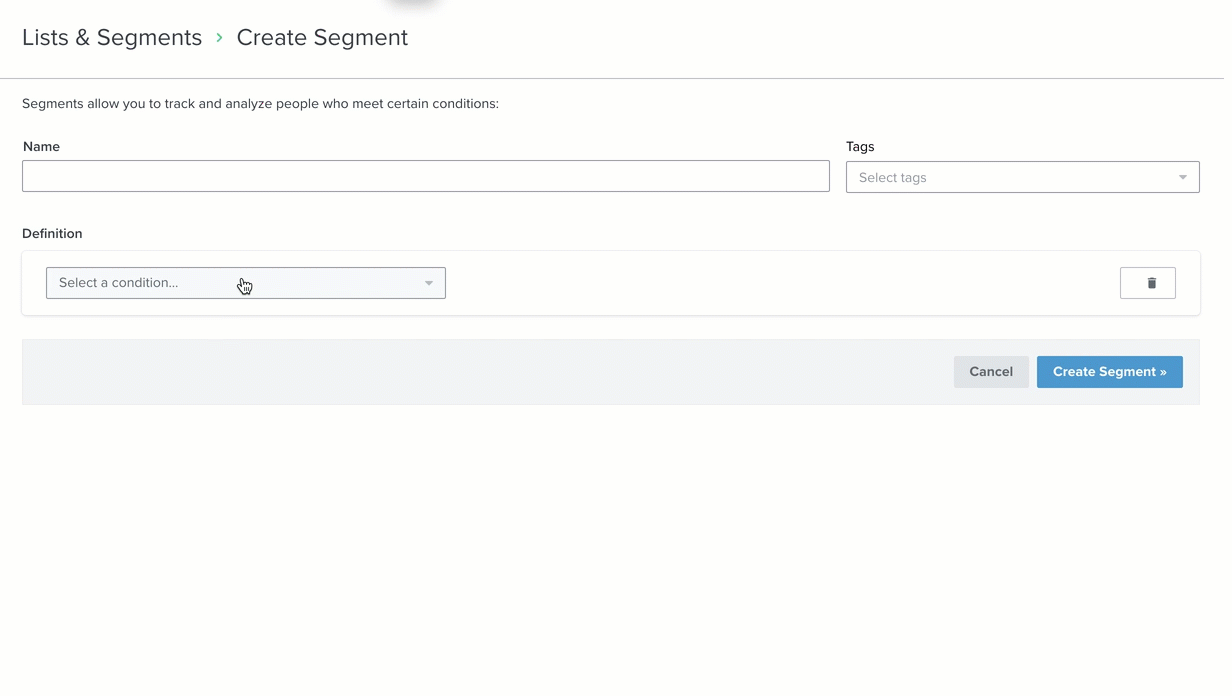
“This will be a smaller segment than what you’re used to,” points out Dayna Scandone, senior digital strategist at Klaviyo. “If the email marketing campaign is important, you can always follow up with a second campaign to everyone else and use Smart Sending to ensure no one gets the campaign twice.”
8 email subject line best practices for boosting open rates
With all that in mind, here are 8 email subject line first principles and best practices to test for your own brand and audience.
1. Personalization makes email subject lines stand out in the inbox
Generally speaking, the larger the company, the more likely they are to use personalization in email subject lines. Recent Klaviyo research finds that mid-market companies, for example, tend to personalize 3.35% of their email subject lines with the recipient’s first name, while small to midsize businesses only do so in 2.45% of their email subject lines.
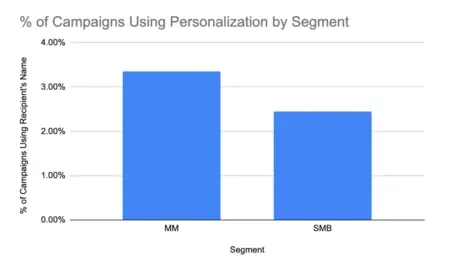
Most of the time, “personalization” in a subject line means using the reader’s first name—but our research suggests first name alone won’t do much to increase your open rates.
Brands that are squeezing every ounce of value from audience segmentation are driving better results with deeper personalization tactics. This is because audience segmentation, when paired with personalization, increases the relevance of your email content—and that’s the single most important ingredient for driving opens, clicks, and conversions.
Klaviyo customers can segment in an endless number of ways based on customer data and cohorts. One of the most popular and effective is using predictive analytics segmentation, powered by AI.
This tool predicts customer lifetime value, repeat purchase rate, and churn—and it lets a marketer create segments based on those predictive metrics to increase customer lifetime value and loyalty or even mitigate churn.
How to personalize email subject lines in Klaviyo
Scandone, who works with Klaviyo customers day in and day out, says her favorite way to personalize a subject line “is to reference the name of the product for an abandoned browse or abandoned cart automation.” Review requests or replenishment reminders are also great places to use this syntax, she adds.
So how do you actually accomplish this in Klaviyo? The answer is dynamic variables—which sounds advanced, but is actually just a tagging system that pulls information from your B2C CRM into your subject line. For a first name, it looks something like this:
{{ first_name|default:’there’ }}
Here, “first name” will be replaced in the subject line with the recipient’s actual first name. But if a brand doesn’t have access to someone’s first name, the “default:’there’” instructs the email platform to replace the name value with “there” (for “Hey there”).
For a product title, the tag may look something like this:
{{ event.extra.line_items.0.product.title }}
Once you have a handle on product titles in subject lines, you can go even further by collecting more nuanced data through quizzes and other forms and using that information in subject lines. For example, if you’re a skincare brand and your quiz asks the customer what type of skin they have, you might craft a subject line like this: [First Name], shop [moisturizers] for [sensitive] skin.
Visit our help center for more ways to use dynamic variables.
2. Email subject lines perform better when they’re short
“Most email opens are happening on mobile devices, so it’s critical to think mobile-first when you’re writing subject lines,” Scandone points out. “You should always be testing your campaigns on desktop and mobile to ensure they’re showing up exactly how you want them to, and that includes the subject line.”
According to our research, as subject lines get wordier, subscribers on your email list are less likely to open your emails.
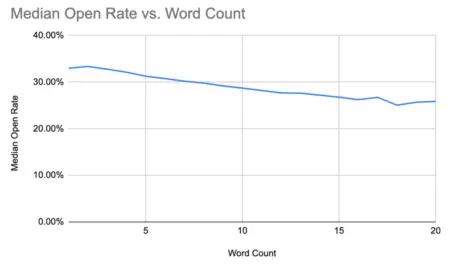
So, how long should your subject lines be? On average, subject lines across all business sizes are about 7 words long (including emojis). According to our data, subject lines of this length drive open rates of about 30%.

If you want to challenge yourself to shorten your subject lines even more—and potentially boost open rates—you can lean on another important tool for piquing curiosity: preview text.
3. Thoughtful email preview text can promise a solution to a problem
We can’t talk about subject lines without mentioning the importance of preview text.

“Solving a pain point in your subject line can work well to encourage email opens,” says Toccara Karizma, CEO of Karizma Marketing. One of the best ways to do this is to present it in your subject line and hint at a solution in your preview text.
4. Urgency and scarcity prompt opens—but proceed with caution in email subject lines
Limited-time offers, exclusive offers, “running out of stock” emails, and clearance sales are actually about creating urgency and scarcity—two things that inspire people to act. The most obvious way to create a sense of urgency is using phrases like “limited time” and “ending soon.”
A word of caution: While these kinds of words don’t have the same detrimental effect on email deliverability as they used to, we still recommend careful and appropriate use based on your audience to make sure your email doesn’t end up in the spam folder.
Whereas an audience segment with low purchase intent might find your use of urgent language, exclamation points, and all caps annoying, a segment with high buying intent or purchase history may welcome it.
5. Context rules all good content performance of email subject lines
“Consider the context [of your email],” says Nikki Elbaz, an email copywriter. “By context, I mean the inbox. What kinds of emails does your subscriber usually receive? Will emojis/questions/whatever style subject lines you’re writing stand out or blend in?”
Most email marketers understand context, in theory—they know their emails are showing up in flooded inboxes, received by overwhelmed, busy people. But hyper-personalization is how you can overcome some of this information overload.
For example, if you can see from customer data that someone has visited a product page a certain number of times, this is a context-based signal that you can send them an email with a mention of that product in the subject line. Time of day, quiz results, discount shopping, high intent to buy, and high churn risk are all examples of contextual elements that can increase the intrigue of a subject line in a crowded inbox.
6. Most great email subject lines create a curiosity gap
The curiosity gap is the “space between the information we’re given (what we know) and the information that’s initially withheld (what we don’t know),” according to Enchanting Marketing. This is what you want to create with your email subject line‚ because opening your email is how your audience closes the gap.
Curiosity is especially important if you’re hyping a new product, collection, or campaign that hasn’t launched yet. But keep in mind that what you spark curiosity about will depend on the purchase intent of your audience segment.
In the early stages of an email subscriber relationship, you may want to spark curiosity about the more salient points of your brand story or the problems you solve. But after you’ve established a relationship and subscribers are indicating higher purchase intent—through website visits, abandoned carts, and more—that’s when you might want to spark curiosity about your actual product releases.
A word of caution: Just as you wouldn’t enjoy reading a novel without a resolution, email recipients don’t appreciate a curiosity gap that stays open. If you’re going to pique curiosity in a subject line, make sure your email copy keeps its promise by satisfying that curiosity.
7. Emojis aren’t bad in email subject lines, but use them sparingly
If you’re trying to stand out in a crowded inbox, you might think emojis are a good way to get noticed. But you may be blending in more than you realize: according to Klaviyo research, 42% of mid-market businesses and 43.5% of SMBs use emojis in their subject lines.
Here are some quick tips for using emojis in subject lines:
- Don’t use more than one.
- Use emojis to amplify the message, not replace words.
- Remember that the goal of the subject line is to deliver a clear message. If an emoji helps you do that, go for it.
A word of caution: Emojis show up differently depending on the inbox provider, so make sure to preview your subject lines across inbox providers and devices.
8. Test AI to craft email subject lines at scale based on past performance
Artificial intelligence may not be a great writer (yet). But it’s an effective assistant when:
- You don’t know where to start with crafting subject lines.
- You need to create a lot of subject lines at once.
- You have enough past performance data to inform current subject lines.
More on that last point: Klaviyo’s AI subject line assistant learns over time what’s working for your brand and offers ways to learn from and improve your future subject lines. If you like one of the suggestions, it’s easy to copy and paste it into your subject line field. Click refresh under any suggestion for more examples.
And if you’re struggling to remember some of the best practices from this article, you can find them within the subject line assistant itself. Recommended length, ways to evoke curiosity, and other tips bespoke to your brand are there to help on the spot.
9 email subject line examples that stand out in inboxes
1. Supply uses an emoji to convey context
Subject line: This email is better than 👇
It’s one thing to understand that inboxes are overflowing, but it’s another to use that fact to your advantage with your subject line.
Shaving brand Supply makes damn good use of an emoji to show they understand the context of the average inbox. With solid reinforcement from their preview text, Supply crafts one of the most creative yet simple subject lines we’ve ever seen.

Image source: X
2. Dagne Dover prioritizes mobile with a punchy subject line
Subject line: To you, from you
You don’t necessarily need a super short subject line to see high email open rates—remember that the average word count is 7, according to our research. But at the very least, your subject line should look great on mobile.
Dagne Dover, the brand that creates “problem-solving bags for problem-solving humans,” demonstrates a mobile priority with this subject line that’s just 4 words long. It stands out in an inbox not only because it’s shorter than other subject lines, but also because it’s so concise and direct.

Image source: Dagne Dover
3. Beekman 1802 builds urgency for a free offer
Subject line: LAST CALL 📣 Free Mini Milk Drops
All caps, an emoji, and a freebie available for a limited time—these are the ingredients of a subject line that inspires a sense of urgency.

Image source: Beekman 1802
Assuming skincare brand Beekman 1802 sent out a couple emails before this one to communicate the offer, this is a great subject line for everyone on the email list who didn’t buy during previous rounds. If you’re sending last chance reminders like this, you’ll want to exclude people in the segment who already took action from previous emails in the series.
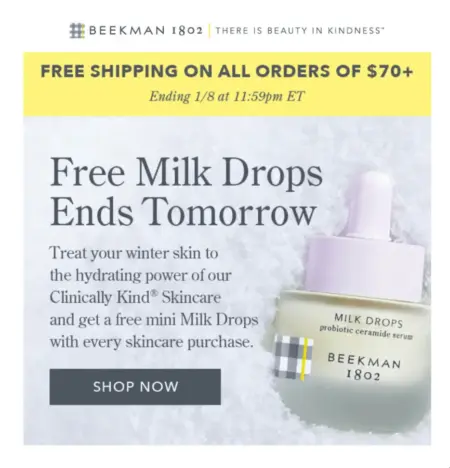
Image source: Beekman 1802
4. Dossier creates a curiosity gap for customers
Subject line: ✨Something NEW is coming…✨
If you’re sending an email to customers—especially VIPs—what better way to hook them than with something new?

Image source: Dossier
Fragrance brand Dossier evokes curiosity with this simple, clear subject line. It may not work on people who don’t have high purchase intent, but on the flip side, it can work really well on people who have bought before. (Ahem—this is why email segmentation is so important.)
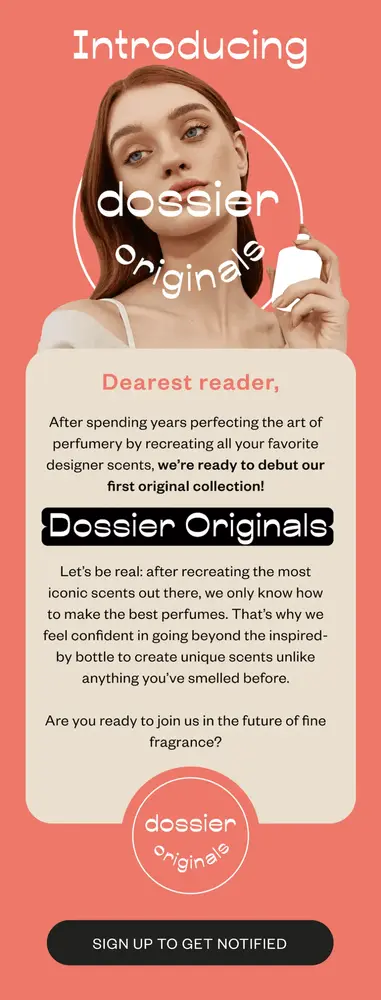
Image source: Dossier
5. Reverie’s subject line and preview text go hand in hand
Subject line: Are you washing your hair properly?
Preview text: How to do it right
Haircare brand Reverie hints at solving a pain point by asking a provocative question in their subject line and expanding on it with their preview text. It’s a great example of how to keep your subject line short while using the extra real estate of your preview text to widen the curiosity gap.

Image source: Reverie
6. House Of Harlow 1960 plays into the popularity contest
Subject line: Our most popular necklace is back in stock!
If something goes out of stock quickly, it must be good, right? A subject line that says, “Our most popular necklace is back in stock!” makes customers want to check it out immediately. House Of Harlow 1960 is a well-known jewelry brand that uses this tactic to inform customers when a bestseller is available again.

Image source: Milled
7. Fly by Jing demonstrates empathy for tough holidays
Subject line: Want to opt out of Father’s Day?
Sauce and seasoning brand Fly By Jing thinks ahead of Father’s Day by thinking about people who may not want to celebrate it. With a subject line that hits home for many, the brand pulls people in with the most important marketing attribute: empathy.
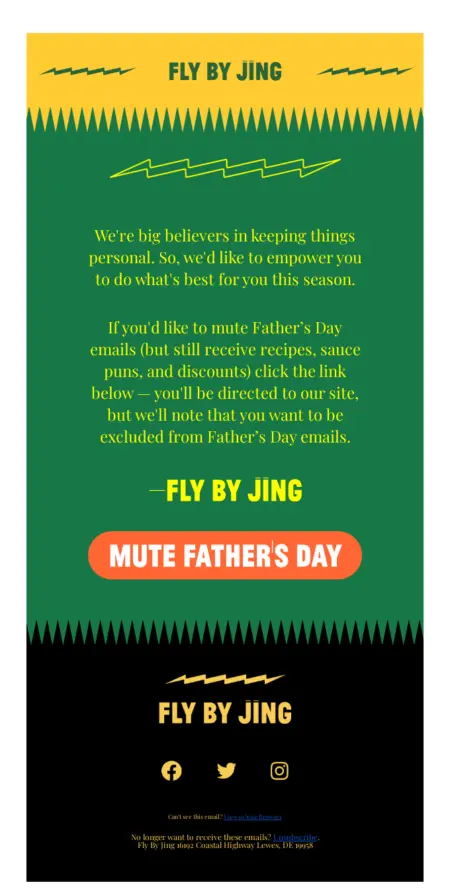
Image source: ReallyGoodEmails
8. OSEA gets personal with a unique discount nudge
Subject line: Your 10% Off Ends Soon!
Vegan skincare brand OSEA Malibu draws people in with the most powerful subject line tactic there is: personalization.

Image source: OSEA Malibu
When we hear “personalized email subject lines,” we often think first or last names. But this simple subject line takes personalization beyond the surface level by using the email recipient’s unique profile data—in this case, an expiring coupon code—to encourage an imminent purchase.

Image source: OSEA Malibu
9. Wildfang sends a friendly—and witty—reminder
Subject line: Did I just get ghosted?
Genderless apparel brand Wildfang pairs witty copy with personalization in the subject line of this browse abandonment email automation.

Image source: Wildfang
By combining a reference to the recipient’s unique web browsing history with a cute spin on a phrase from the world of dating apps, the brand crafts a question that’s hard for their audience to resist answering in the form of an open.
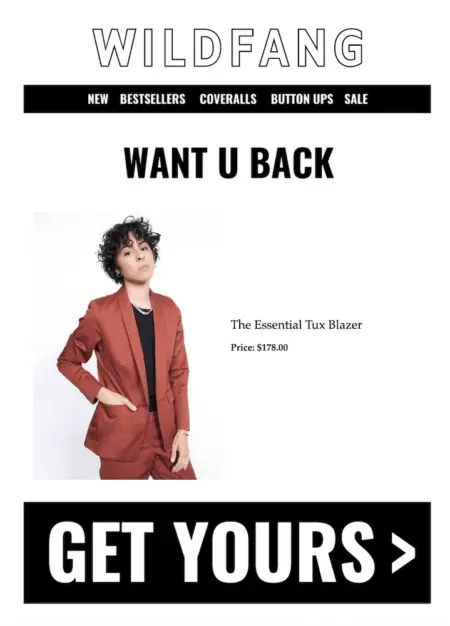
Image source: Wildfang
Next steps: A/B test these elements for your email subject line
We’ve handed over the subject line knowledge, but to discover what works best for your brand, you’ll need to A/B test each element. Based on these best practices, test these one at a time:
- Product name mention vs. first name only
- Subject line word count
- Preview text wording
- Urgency language vs. softer language
- Email context scenarios
- One emoji vs. none
- AI-generated subject lines vs. human-generated subject lines
What’s next: personalize your email subject lines with a B2C CRM
Your email subject lines are only as good as you’re able to personalize them—and your personalization is only as good as your customer data.
Klaviyo B2C CRM—the only CRM built specifically for B2C—is the single platform that makes it easy to personalize thousands or even millions of subject lines at scale.
B2C marketers face the impossible task of making countless subject lines feel personal to every subscriber and customer. A CRM that integrates with 350+ other B2C software platforms and combines marketing, services, and analytics in one platform is how this becomes possible—even simple.


